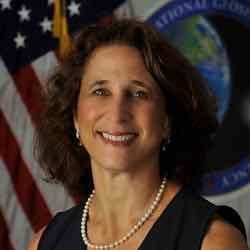

Algorithms are representations of analytic models that reside in the heads of analysts. To automate an algorithm, analysts have to be able to describe those models in a way that can be coded in software.
February 26, 2019

A Conversation with Sue Kalweit, National Geospatial-Intelligence Agency (NGA), director of the Analysis Directorate
Analysts at the National Geospatial-Intelligence Agency (NGA) often work behind the scenes, providing maps and data to policy makers, the armed forces, intelligence agencies, and first responders. Their work—much of it done using geographic information system (GIS) technology—supports critical military, political, and humanitarian missions worldwide. Now, NGA teams are receiving support from artificial intelligence and machine learning to process data and help speed the delivery of powerful geospatial intelligence, known as GEOINT.
Sue Kalweit, NGA director of the Analysis Directorate, has been heavily involved in the agency’s modernization, focusing on data science, artificial intelligence, and automation.
Kalweit addressed the audience at Esri’s Federal GIS Conference in Washington, D.C. on January 29, 2019. We spoke to her at the event about taking advantage of all available data; map-based deliverables evolving to meet customer needs; and how to add automation to analysis while maintaining customer confidence and trust.
This interview has been edited and condensed.
You refer to the human-machine team. How do you break down the responsibilities of this partnership?
There’s no doubt machines excel at processing lots of data, connecting dots, and uncovering trends and patterns. Machines process data faster, and humans can get overwhelmed by large volumes of data.
However, machines are not creative thinkers. They don’t work collaboratively with others to bring diverse viewpoints and opinions together. That’s what people do best.
So, when you pair humans and machines you get a really powerful team to take advantage of the explosion of data. It’s not just remotely sensed imagery that has grown exponentially, everywhere you look there are sensors and sources that provide spatially and temporally referenced data.
Defense mapping has historically been done behind closed doors, but increasingly your work is in the public eye. To what do you attribute this openness?
People who haven’t been our long-standing customers are now needing our products and services. The Ebola epidemic stands out because the global community of health workers needs our information and data visualizations to support the humanitarian response. It became an imperative for us to open up and share what we had for the good of the world.
On top of that, the explosion of imagery from commercial remote sensing companies, and our need for what the commercial marketplace offers, has pushed us to work in the open. We have learned to use commercial imagery and the data the geospatial industry creates from that imagery.
We owe it to the defense, intelligence, and national security communities we serve to use all available data to help answer questions, plan missions and operations, and identify threats. It only makes sense to expose what we’re doing and reach a hand out to the private sector.
Industry tends to innovate more quickly than the public sector can, and our customers need us to be at the top of our game. We need to get inside our adversaries’ decision and action cycles, therefore, we need to take advantage of innovation.

Algorithms are representations of analytic models that reside in the heads of analysts. To automate an algorithm, analysts have to be able to describe those models in a way that can be coded in software.
How have the products you deliver evolved to use the increasing volume of data?
Historically, and to a large extent today, we produce static visual products made from digital data. When we talk about GEOINT at the speed of need, we’re allowing our customers to interact with information, ask questions, and visualize data in meaningful ways.
We are delivering a new wave of interactive applications to meet mission needs and add to static products. We’re soliciting feedback to make sure what we deliver fits our users’ needs. Customer feedback is incredibly valuable to our data collection and knowledge cycle.
In some cases, we create a digital map to provide the common operational picture with direct input from forces in the field. To that we add updated threat intelligence. If the customer wants a map to share with others, such as for diplomatic purposes, then it’s updated to be releasable. Both are made from the same data, created once and used many times.
With the move to interactive apps, has the paper map gone away?
I believe the Defense Logistics Agency (DLA), which provides paper maps to the war fighter, is as busy as ever. I don’t think the day of paper maps has gone away. We will continue to support our partners at DLA, particularly until the war fighter has the means, equipment, and doctrine to operate in a completely digital mapping environment.
As the director of the Analysis Directorate, do you spend a great deal of time staying on top of the rapidly evolving field of data science?
We are busy developing the tradecraft and standards necessary to apply data science to our analytic mission with rigor. I don’t foresee having a workforce of 100% data scientists, but everybody needs to be conversant with the world of data science—understanding where data comes from, how it is structured, and how algorithms are developed.
Algorithms are representations of analytic models that reside in the heads of analysts. To automate an algorithm, analysts have to be able to describe those models in a way that can be coded in software.
Data scientists need to understand something about geopolitics, doctrine and tactics of foreign adversary military forces. Analysts need to think about data science skills in the context of answering questions for our customers.
How do you evaluate the quality of your answers?
There are intelligence community-wide standards. Applying these standards to our work is important to maintaining quality and accuracy in our reports. Standards help us avoid political bias in our analysis and ensure we are conducting analysis of alternatives.
In this era we at NGA call AAA “Automation, Augmentation and Artificial Intelligence,” we have to make sure we apply tradecraft standards. In our analytic reports, we cite the imagery used. We must decide what to cite when an algorithm makes the same type of observation, such as an observation of aircraft present at an airfield. Do we cite the algorithm, the data source the algorithm used, or the analytic model embedded in the algorithm?
These are all questions we are now thinking through in our work to establish processes for governance and algorithm validation to adequately assess algorithm quality.
Learn more about Esri solutions for defense and intelligence organizations.


